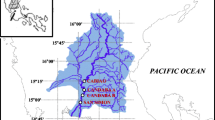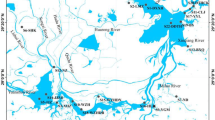Abstract
This study investigates the presence and distribution of organochlorine pesticides in streams and the lake in the Sembrong Lake Basin in Malaysia. The catchment of Sembrong Lake has been converted to agricultural areas over the past 30 years, with oil palm plantations and modern agricultural farming being the main land use. Surface water samples were collected from eight sites comprising the stream and lake and analysed for 19 organochlorine pesticides (OCPs). In situ measurement of temperature, dissolved oxygen, pH and conductivity were also undertaken at each site. Aldrin, endrin, δ-BHC, 4,4-DDT, methoxychlor and endosulfan were the main OCPs detected in the lake basin. The total OCP concentration ranged between 5.42 and 349.2 ng/L. The most frequently detected OCPs were δ-BHC, heptachlor and aldrin. The maximum values detected were 23.0, 43.2 and 50.4 ng/L respectively. The highest concentration of OCPs was attributed to 4,4-DDT, but such high residue was rare and only detected once. Other OCP residues were low. Significant differences in the mean values were observed between lake and stream for dichlorodiphenyldichloroethylene (DDE) and α-endosulfan concentration (p < 0.05). The highest endosulfan, endrin and methoxychlor residues were found in lake sites, while the highest 4,4,-DDT residues were observed for the river sites. Temporal variation of OCP residues was observed for heptachlor and β-endosulfan. The highest concentrations of pesticide residues were found in October. DDX and α/ɣ ratios indicate possible fresh inputs of the OCP pesticide in the basin.



Similar content being viewed by others

References
Abdullah, A. R. (1995). Environmental pollution in Malaysia: trends and prospects. Trends in Analytical Chemistry, 14, 191–198.
Abdullah, A. R. (2002). Pesticide use in Malaysia. In M. D. Taylor, S. J. Klaine, F. P. Carvalho, D. Barcelo, & J. Everaarts (Eds.), Pesticide residues in coastal tropical ecosystems. London: CRC Press.
Abdullah, M. P., Abdul Aziz, Y. F., Othman, M. R., & Wan Mohd Khalik, W. M. A. (2015). Organochlorine pesticides residue level in surface water of Cameron Highlands, Malaysia. Iranica Journal of Energy and Environment, 6, 141–146.
Abdullah, S. A., & Hezri, A. A. (2008). From forest landscape to agricultural landscape in the developing tropical country of Malaysia: pattern, process, and their significance on policy. Environmental Management, 42, 907–917.
APHA. (2012). Standard methods for the examination of water and waste water. Washington: American Public Health Association (APHA).
Awang, H., Daud, Z., & Mohd. Hatta M.Z. (2015). Hydrology properties and water quality assessment of the Sembrong Dam, Johor, Malaysia. Procedia - Social and Behavioral Sciences, 195, 2868–2873.
Baharim, N. B., Yusop, Z., Yusoff, I., Wan Muhd Tahir, W. Z., Askari, M., Othman, Z., & Zainal Abidin, M. R. (2016). The relationship between heavy metals and trophic properties in Sembrong Lake, Johor. Sains Malaysiana, 45, 43–53.
Barlas, N., Cok, I., & Akbulut, N. (2006). The contamination levels of organochlorine pesticides in water and sediment samples in Uluabat Lake, Turkey. Environmental Monitoring and Assessment, 118, 383–391.
Cai, S., Sun, K., Dong, S., Wang, Y. M., Wang, S., & Jia, L. (2014). Assessment of organochlorine pesticide residues in water, sediment, and fish of the Songhua River, China. Environmental Forensics, 15, 352–357.
Caldas, E. D., Coelho, R., Souza, L. C. K. R., & Siba, S. C. (1999). Organochlorine pesticides in water, sediment, and fish of Paranoa Lake of Brasilia, Brazil. Bulletin of Environmental Contamination and Toxicology, 62, 199–206.
Dai, G., Liu, X., Liang, G., Han, X., Shi, L., Cheng, D., & Gong, W. (2011). Distribution of organochlorine pesticides (OCPs) and poly chlorinated biphenyls (PCBs) in surface water and sediments from Baiyangdian Lake in North China. Journal of Environmental Sciences, 23, 1640–1649.
Darko, G., Akoto, O., & Oppong, C. (2008). Persistent organochlorine pesticide residues in fish, sediments and water from Lake Bosomtwi, Ghana. Chemosphere, 72, 21–24.
Dikshith, T.S.S., & Diwan, P.V. (2003) Industrial guide to chemical and drug safety. Wiley-Interscience, New Jersey
DOA. (2014). List of banned and restricted pesticide database 2014. Putrajaya: Department of Agriculture.
Donald, D. B., Cessna, A. J., & Sverko, N. E. G. (2007). Pesticides in surface drinking-water supplies of the northern Great Plains. Environmental Health Perspectives, 115, 1183–1191.
Fosu-Mensah, B. Y., Okoffo, E. D., Darko, G., & Gordon, C. (2016). Organophosphorus pesticide residues in soils and drinking water sources from cocoa producing areas in Ghana. Environmental Systems Research, 5. https://doi.org/10.1186/s40064-016-2352-9.
Gitahi, S. M., Harper, D. M., Muchiri, S. M., Tole, M. P., & Ng’ang’a, R.N. (2002). Organochlorine and organophosphorus pesticide concentrations in water, sediment, and selected organisms in Lake Naivasha (Kenya). Hydrobiologia, 488, 123–128.
Golfinopoulos, S. K., Nikolaou, A. D., Kostopoulou, M. N., Xilourgidis, N. K., Vagi, M. C., & Lekkas, D. T. (2003). Organochlorine pesticides in the surface waters of northern Greece. Chemosphere, 50, 507–516.
Gupta, A., Bhatnagar, P., & Bakre, P. P. (2016). Residues of organochlorine insecticides in water and sediment from Ramgarh water reservoir, Jaipur, Rajastan. Journal of Entomology and Zoology Studies, 4, 397–401.
Ismail, B. S., Haron, S. H., & Latif, M. T. (2012). Pesticide residue levels in the surface water of the irrigation canals in the Muda Irrigation Scheme Kedah, Malaysia. International Journal of Basic & Applied Sciences, 12, 85–90.
Iwata, H., Tanabe, S., Ueda, K., & Tatsukawa, R. (1995). Persistent organochlorine residues in air, water, sediments, and soils from the Lake Baikal region, Russia. Environmental Science & Technology, 29, 792–801.
JPS, & UTHM. (2012). Tasik Empangan Sembrong, Batu Pahat Johor. In In: Managing lakes and their basins for sustainable use in Malaysia (Lake Briefs Report Series III). Seri Kembangan: NAHRIM.
Keilty, T. J., White, D. S., & Landrum, P. F. (1988). Short-term lethality and sediment avoidance assays with endrin-contaminated sediment and two oligochaetes from Lake Michigan. Archives of Environmental Contamination and Toxicology, 17, 95–101.
Konstantinou, I. K., Hela, D. G., & Albanis, T. A. (2006). The status of pesticide pollution in surface waters (rivers and lakes) of Greece. Part I. Review on occurrence and levels. Environmental Pollution, 141, 555–570.
Larson, S. J., Capel, P. D., & Majewski, M. S. (1998). Pesticides in surface waters: distribution, trends, and governing factors. Michigan: CRC Press.
Leong, K. H., Tan, L. L. B., & Mustafa, A. M. (2007). Contamination levels of selected organochlorine and organophosphate pesticides in the Selangor River, Malaysia between 2002 and 2003. Chemosphere, 66, 1153–1159.
Mamta, Rao, R. J., & Wani, K. A. (2015). Monitoring of organochlorine and organophosphorus pesticide residues in water during different seasons of Tighra reservoir Gwalior, Madhya Pradesh. India. Environmental Monitoring and Assessment, 187. https://doi.org/10.1007/s10661-015-4889-4.
Meier, P. G., Fook, D. C., & Lagler, K. F. (1983). Organochlorine pesticide residues in rice paddies in Malaysia, 1981. Bulletin of Environmental Contamination and Toxicology, 30, 351–357.
MOH (2004). National Standard for Drinking Water Quality. Putrajaya: Engineering Services Division, Ministry of Health (MOH).
Nyangababo, J. T., Henry, L., & Omutange, E. (2005). Organochlorine pesticide contamination in surface water, sediment, and air precipitation of Lake Victoria Basin, East Africa. Bulletin of Environmental Contamination and Toxicology, 75, 960–967.
Ormad, M. P., Miguel, N., Claver, A., Matesanz, J. M., & Ovelleiro, J. L. (2008). Pesticides removal in the process of drinking water production. Chemosphere, 71, 97–106.
Petrovic, M., Gonzalez, S., & Barcela, D. (2003). Analysis and removal of emerging contaminants in wastewater and drinking water. Trends in Analytical Chemistry, 22, 685–696.
Saadati, N., Abdullah, M. P., Zakaria, Z., Rezayi, M., & Hosseinizare, N. (2012). Distribution and fate of HCH isomers and DDT metabolites in a tropical environment: case study Cameron Highlands, Malaysia. Chemistry Central Journal, 6, 130.
Sharip, Z., Zaki, A. T. A., Shapai, M. A. H., Suratman, S., & Shaaban, A. J. (2014). Lakes of Malaysia: water quality, eutrophication and management. Lakes & Reservoirs: Research & Management, 19, 130–141.
Sharip, Z., Yusoff, F.M., & Ismail, W.R. (2017) Trophic state characterization for Malaysian lakes. In: Maghfiroh, M., Dianto, A., Jasalesmana, T., Melati, I., Samir, O., & Kurniawan, R. (Eds.), Lake Ecosystem Health and Its Resilience: Diversity and Risks of Extinction, Proceedings of 16th World Lake Conference (pp 442–447). Bali: Research Centre for Limnology, Indonesian Institute of Science.
Singh, G. K. S., Kuppan, P., Goto, M., Sugiura, N., Noor, M. J. M. M., & Ujang, Z. (2013). Physical water quality and algal density for remediation of algal blooms in tropical shallow eutrophic reservoir. Journal of Novel Carbon Resource Sciences, 7, 33–41.
US EPA. (2007). Method 8081: organochlorine pesticides by gas chromatography. Washington: US Environmental Protection Agency.
Vijgen, J., Abhilash, P., Li, Y., Lal, R., Forter, M., Torres, J., Singh, N., Yunus, M., Tian, C., Schaffer, A., & Weber, R. (2011). Hexachlorocyclohexane (HCH) as new Stockholm convention POPs: a global perspective on the management of Lindane and its waste isomers. Environmental Science and Pollution Research, 18, 152–162.
Wandiga, S. O. (2001). Use and distribution of organochlorine pesticides. The future in Africa. Pure and Applied Chemistry, 73, 1147–1155.
Wauchope, R. D. (1978). The pesticide content of surface water draining from agricultural fields: a review. Journal of Environmental Quality, 7, 459–472.
Wellson, R., Othman, N., & Matias-Peralta, H.M. (2016). The characterization of chlorophyll-a and microalgae isolation process of wastewater collected at Sembrong Dam. IOP Conference Series: Materials Science and Engineering (Vol. 136, p 012062). Bristol: IOP Publishing.
Yamashita, N., Urushigawa, Y., Masunaga, S., Walash, M. I., & Miyazaki, A. (2000). Organochlorine pesticides in water, sediment and fish from the Nile River and Manzala Lake in Egypt. International Journal of Environmental Analytical Chemistry, 77, 289–303.
Zakaria, Z., Heng, L. Y., Abdullah, P., Osman, R., & Din, L. (2003). The environmental contamination by organochlorine insecticides of some agricultural areas in Malaysia. Malaysian Journal of Chemistry, 5, 078–085.
Acknowledgements
This study was supported by the Ministry of Natural Resources and Environment funding (P9500000421). The authors would like to thank M. Azril Hilmi Shapiai, A. Taqiyuddin, A. Zaki, M. Hafiz Zulkifli and Nur Hishaam Sulaiman for their support in the field. Special appreciations to Datuk Ir Dr. Azuhan Mohamed and Datuk A. Jamalluddin Shaaban for their management support on the work. The authors thank the two anonymous reviewers for their useful comments to improve the manuscript.
Author information
Authors and Affiliations
Corresponding author
Rights and permissions
About this article
Cite this article
Sharip, Z., Hashim, N. & Suratman, S. Occurrence of organochlorine pesticides in a tropical lake basin. Environ Monit Assess 189, 560 (2017). https://doi.org/10.1007/s10661-017-6274-y
Received:
Accepted:
Published:
DOI: https://doi.org/10.1007/s10661-017-6274-y



